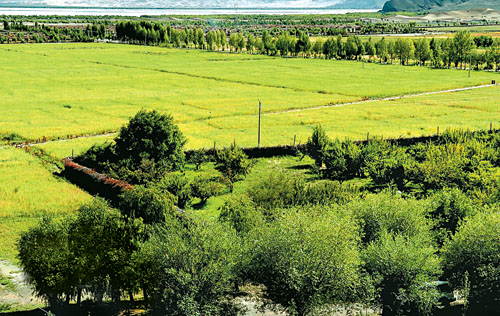|
 Efforts have been made to treat sound in the middle reaches of the Yarlung Zangbo River. Land there is now suitable for farming
Efforts have been made to treat sound in the middle reaches of the Yarlung Zangbo River. Land there is now suitable for farming
Since the natural forest protection project was implemented in 2000, Tibet has completely ceased felling natural forests for commercial purposes, carried out the management and protection of 1.2 million hectares of natural forests throughout the year, and closed 18 timber processing plants and three timber exchange markets. These measures have cut the quota of felling forest resources to a large extent, with the forest resources consumption and the output of timber for commercial purpose decreasing 46.1 percent and 100 percent. After ceasing felling for commercial purposes, the original forestry industry enterprises under counties in the project areas all turned towards effective recovery and restoration development. Thanks to good management and protection, in recent years, Tibet's forest diseases and insect pest prevention and control rates have reached 100 percent, and the cases of illegal felling of trees, hunting of the animals and occupying the forest have not occurred in the project areas. The forest resources have increased year after year, the ecological function of forest has been further restored, and the ecological situation has been markedly improved.
In 2007, Tibet actively carried out projects to protect the natural forests, to reconvert farmland into forest and to convert pasture into grassland. A total of 22,700 hectares of land was forested. Of them, 7,113 hectares of land in the key areas was forested, 3,333 hectares of cultivated land restored to forest, trees were planted on 6,667 hectares of barren mountains and wasteland, 12,933 hectares of land was reforested, trees were planted on 2,740 hectares of land through compulsory tree-planting, 533 hectares of production forest was constructed, and 987 hectares of forest was constructed on other areas. The new area for closing off hillsides to facilitate forestation was 42,500 hectares; tree seedlings were grown on 193.3 hectares of land; 1.753 million hectares of pasture was restored to grassland. In the same year, Tibet also implemented the ecological public welfare forest construction project in the key areas such as in towns and their vicinity, along trunk highways, around airports, and in the scenic areas and border ports. It also started the preparatory work for the Tibet Plateau National Ecological Security Barrier Protection and Construction Project and strengthened the management and protection of the projects to reconvert farmland to forest and administration over the forestry market.
In December 2006, Tibet launched five projects for the protection and recovery of natural forest resources with estimated total investment of 14.351 billion Yuan. They include the project for the protection and recovery of natural forests, project for the construction of a shelterbelt system, project for the control and prevention of desertification, project for the construction of rare wild animals and plants protection areas, nature reserves and wetland protection areas, and project for the ecological forestry safety system. Among them, the project for the protection and recovery of natural forests, with a construction area of 8.48 million hectares and total investment of 10.043 billion Yuan, will carry out the protection and recovery of natural forest with fragile ecology as well as in the key areas around the headwaters of rivers, areas along national and provincial highways and the Qinghai-Tibet railway and around key reservoirs. The project for the construction of a shelterbelt system, with total investment of 287 million Yuan, will create shelter forests covering 48,541 hectares on the banks of the rivers causing severely ecological disasters and greatly influencing the production and living of farmers and herders, on the sides of thoroughfares (railway, national highway and provincial highways), around towns, in the main fields and on the two mountains in north and south Lhasa. The project for the control and prevention of desertification plans to harness 306,000 hectares of desert land and move 419 households, totaling 2,069 people, for ecological purposes. With 1.915 billion Yuan investment, it will conduct the control and prevention of desertification in the towns of three prefectures or cities, i.e. Xigaze, Shannan and Lhasa, and around the airports in the drainage areas of the "Three Rivers", in Qamdo Prefecture, and in the drainage area of the Shiquanhe in northwest Tibet. The project for the construction of the rare wild animals and plants protection area on the plateau, nature reserves and wetlands protection areas will elevate the 10 nature reserves, such as Gongbu, Metica Wetland, Sangri, southern Changtang, Putog and the drainage area of the Pargi Yi'ong River to national-class ones, with the investment totaling 312 million Yuan. Project for the ecological forestry safety system is to mainly strengthen the work of forest public security, forest fireproofing, and forest diseases and pest prevention and control, with investment of 912 million Yuan.
(China's Tibet Facts and Figures 2008) |
